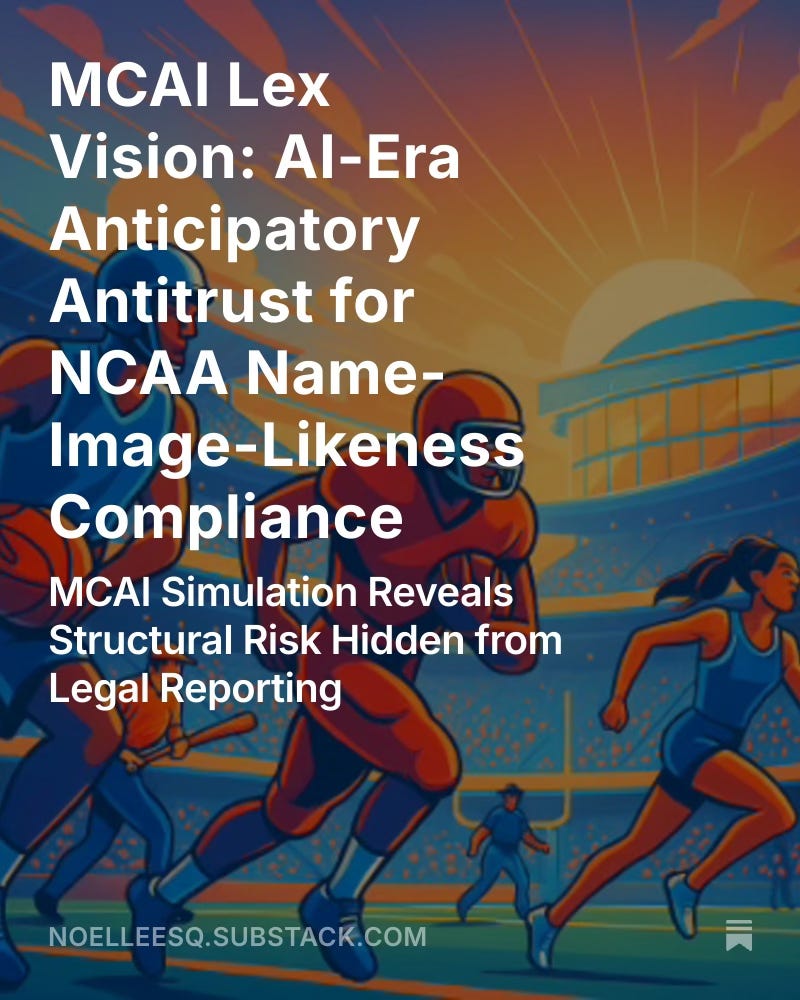MCAI Lex Vision: AI-Era Anticipatory Antitrust for NCAA Name-Image-Likeness Compliance
MCAI Simulation Reveals Structural Risk Hidden from Legal Reporting
For: University Presidents, General Counsel, Trustees, Strategy Officers, and NIL Compliance Leaders ⚠️ MCAI Insight: Peer-mirroring compensation models without public rationale now trigger convergence risk—before any lawsuit is filed.
I. Introduction: A New Lens on NIL Risk
In June 2025, the National Law Review published a clear and timely legal overview of the $2.8B NCAA settlement. The article did what traditional legal commentary does best: summarize the ruling, identify unresolved tensions, and describe the likely contours of future litigation. For general counsel or compliance officers, it’s a useful snapshot of the current legal landscape.
But clarity on what happened is not the same as foresight into what comes next. That’s where MindCast AI (MCAI) enters the picture. This document contrasts standard post-hoc legal analysis with MCAI’s forward-facing simulation framework—illustrating how Anticipatory Antitrust Vision helps universities avoid structural risk before it’s codified in litigation.
Reference Article: Antitrust Labor Markets: $2.8 Billion NCAA Settlement Reshapes College Athletics, National Law Review (July 2025)
II. The Standard Model: What Legal Reporting Offers
Traditional legal reporting plays an essential role in shaping institutional awareness after key events. It organizes complex rulings, spotlights lingering legal ambiguity, and orients schools toward baseline compliance. But by its nature, it describes the past—not the structural pathways through which future risk unfolds.
Traditional antitrust articles provide:
Post-settlement summaries
Section 1 frameworks (labor market vs. product market)
Alerts to potential gaps (Title IX, transfer rules, labor classification)
General observations about exposure
Strength: clarity and legal alignment.
Limitation: no simulation of institutional divergence or stakeholder reaction.
III. The MCAI Upgrade: Simulating Institutional Divergence
MCAI doesn’t just flag risk categories—it models how and where they will surface. Our simulations use Cognitive Digital Twins (CDTs) to recreate how NIL decisions play out across stakeholder groups: athletes, boards, donors, media, and regulators.
We model:
Governance structure impact (centralized vs. distributed)
Transparency differentials (disclosure, athlete voice, narrative control)
Peer-mirroring and policy uniformity (22% ceilings without rationale)
Mission alignment or breakdown (values-based models vs. market mimicry)
Instead of issuing guidance after a DOJ inquiry or public scandal, MCAI helps schools preempt that scrutiny by detecting invisible convergence patterns in real time.
See MCAI Lex Vision: National Name-Image-Likeness Simulation Framework, Strategic NIL Governance Forecast for Peer-Aligned Institutions (July 2025)
IV. Case Comparison: Legal Summary vs. MCAI Simulation
MCAI doesn’t just flag risk categories—it models how and where they will surface. Our simulations use Cognitive Digital Twins (CDTs) to recreate how NIL decisions play out across stakeholder groups: athletes, boards, donors, media, and regulators.
V. Why It Matters
As DOJ enforcement shifts from athlete rights toward educational deference, schools can no longer rely on peer conformity or structural opacity. Uniform NIL ceilings, booster-driven LLCs, and shallow mission statements will no longer shield institutions from scrutiny—they may become the very markers of risk.
Legal summaries are useful for understanding outcomes. But for institutional leaders who want to prevent exposure, design durable policy, and lead with mission coherence, simulation is the missing layer.




